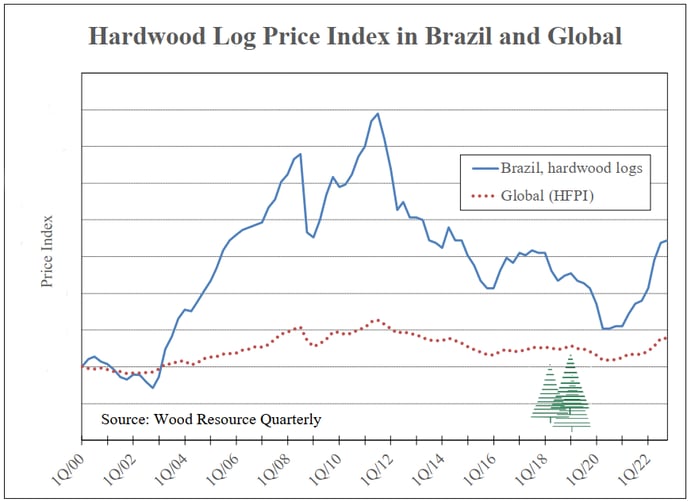Wood costs for pulpmills in Brazil have steadily increased throughout 2021 and 2022. In fact, these numbers have risen considerably faster than other global regions.
In Brazil, prices for softwood and hardwood pulplogs have risen 76% in two years in USD (71% in the Brazilian Real). This is a much faster-paced increase compared to the global average.
The surge came after prices reached an almost 20-year low in late 2020. Like other global wood markets, the COVID Pandemic contributed to this historic low.
Although there have been significant increases in wood fiber costs over the past few years, current levels are still close to their 20-year averages.
Trends in Brazilian Pulplogs Continued Rising Over 10 Years
Prices (in Brazilian Real) for Eucalyptus pulplogs have trended upward for about a decade. The increase was especially fast in the past three years with as much as a 56% rise from 1Q 2020 to 4Q 2022.
Over the past ten years, the US dollar has strengthened against the Brazilian Real. This resulted in wood fiber costs trending downward in USD. However, in the past two years the exchange rate has remained relatively stable.
Ongoing Fluctuation in Brazil Wood Fiber Costs (35 Years and Counting)
Wood fiber costs have fluctuated more in Brazil than any other global lumber market tracked by Wood Resources International over the past 35 years.
In 1988, eucalyptus prices averaged less than $35/bdmt. After that, they remained steady until 2003.
Between 2003 and 2011, prices increased continuously. They peaked at an all-time high in 2011, followed by a downward trend for about nine years.
The downward price trend bottomed out in 2020 – much like other global wood prices. The dip was especially pronounced in Brazil, however. The 2020 price reflected a 16-year low.
From 2020 through 4Q 2022, prices have steadily risen to their highest levels since 2014. They remain somewhat even without nearly as much volatility encountered as the world responded to the COVID pandemic.
Brazilian Wood Fiber Shows Greater Instability than Other Regions
Relative to the Global Hardwood Fiber Price Index (HFPI), Brazilian wood fiber prices have fluctuated more and increased faster over the past two decades.
While the HFPI has increased about 40% since 2000, eucalyptus log prices in Brazil have increased almost 200% over the same period (see chart).

Several factors have contributed to this enormous rise in overall costs:
- Continued Rise in Demand Post-COVID
- Increased Competition for Logs
- Longer Transportation Distances
- Higher Labor Costs
All these factors have contributed to Brazil's wood fiber prices rising quicker than the global average.
How WoodMarket Prices Helps Your Strategic Planning
WoodMarket Prices is a convenient, one-stop repository for the datasets and analytical tools imperative for success in the forest supply chain. Available fully online, you can enjoy a powerful and accessible price tracking solution for all major global markets.
The platform includes price and trade data and trending market commentary on critical industry developments. This crucial data can be visualized and analyzed based on your exact needs. You can save custom search filters, download datasets and customized images, and print charts and graphs.
Learn more about WoodMarket Prices today and schedule a demo to see how it can benefit your business planning and decision-making.






